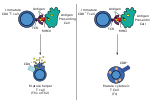Search results
Appearance
The page "Thymus-dependent antigen" does not exist. You can create a draft and submit it for review or request that a redirect be created, but consider checking the search results below to see whether the topic is already covered.
- The thymus (pl.: thymuses or thymi) is a specialized primary lymphoid organ of the immune system. Within the thymus, thymus cell lymphocytes or T cells...43 KB (5,063 words) - 02:46, 15 September 2024
- Cytotoxic T cell (redirect from Cytotoxic T-lymphocyte–associated antigen 4)process can occur via two pathways: thymus-independent (by infected APCs) or thymus-dependent (by CD4+ T cells). In the thymus-independent pathway, because the...31 KB (3,843 words) - 10:18, 12 August 2024
- "non-self" external antigens. Antibodies usually do not react with self-antigens due to negative selection of T cells in the thymus and B cells in the...20 KB (2,435 words) - 20:51, 22 October 2024
- Antigen transfer in the thymus is the transmission of self-antigens between thymic antigen-presenting cells which contributes to the establishment of T...16 KB (1,927 words) - 20:14, 1 June 2022
- subsequent presentation of these antigens on class I or class II major histocompatibility complex (MHC) molecules is dependent on which pathway is used. Both...12 KB (1,763 words) - 18:48, 6 April 2023
- Immune tolerance (redirect from Self-antigen)reactivity toward normal self-antigen that was not eliminated in the thymus can occur, since the T cells that leave the thymus are relatively but not completely...50 KB (6,036 words) - 18:32, 12 August 2024
- T-cell receptor (redirect from Alpha-beta T-cell antigen receptor)organs (thymus for T cells, bone marrow for B cells). Each recombined TCR possess unique antigen specificity, determined by the structure of the antigen-binding...43 KB (5,372 words) - 15:31, 6 August 2024
- then migrate to the thymus gland to develop (or mature). T cells derive their name from the thymus. After migration to the thymus, the precursor cells...71 KB (9,026 words) - 03:44, 25 October 2024
- T cell or thymus independent antigens. T independent antigens are divided into 2 classes by the mechanism of activating B cells. TI-1 antigens have an intrinsic...4 KB (558 words) - 15:36, 6 October 2023
- Major histocompatibility complex (redirect from MHC antigen)their development in the thymus, T lymphocytes are selected to recognize the host's own MHC molecules, but not other self antigens. Following selection,...58 KB (6,785 words) - 20:25, 21 September 2024
- Thymocyte (redirect from Thymus cell)in the thymus, before it undergoes transformation into a T cell. Thymocytes are produced as stem cells in the bone marrow and reach the thymus via the...21 KB (2,589 words) - 10:38, 12 August 2024
- Lymphatic system (section Thymus)pre-adolescent periods. The thymus is located between the inferior neck and the superior thorax. At puberty, by the early teens, the thymus begins to atrophy and...60 KB (6,951 words) - 12:43, 29 October 2024
- host. Following development in the thymus, these cells (termed recent thymic emigrants (RTE)) egress from the thymus and home to secondary lymphoid organs...54 KB (6,597 words) - 14:51, 21 July 2024
- Thymic involution (redirect from Thymus involution)(involution) of the thymus with age, resulting in changes in the architecture of the thymus and a decrease in tissue mass. Thymus involution is one of...19 KB (2,206 words) - 02:29, 22 September 2024
- Medullary thymic epithelial cells (category Thymus)migrate through the bloodstream to the thymus for further development. During their maturation in the thymus, they undergo a process called V(D)J recombination...29 KB (3,544 words) - 18:20, 28 October 2024
- Ki-67 (protein) (redirect from Ki-67 antigen)Antigen Kiel 67, also known as Ki-67 or MKI67 (marker of proliferation Kiel 67), is a protein that in humans is encoded by the MKI67 gene (antigen identified...10 KB (1,365 words) - 02:06, 17 June 2024
- Adaptive immune system (section Antigen presentation)have left the bone marrow or thymus and entered the lymphatic system, but have yet to encounter their matching antigen Effector cells that have been...57 KB (7,167 words) - 11:46, 30 October 2024
- differentiated in the thymus, and successfully undergone the positive and negative processes of central selection in the thymus. Among these are the naive...9 KB (1,142 words) - 13:25, 25 October 2024
- Phagocyte (section Antigen presentation)reactive T cells escape the thymus for a number of reasons, mainly due to the lack of expression of some self antigens in the thymus. Another type of T cell;...75 KB (8,281 words) - 02:06, 9 October 2024
- Immune system (section Recognition of antigen)variety of self-antigens in the thymus, in which iodine is necessary for its thymus development and activity. In contrast, the B cell antigen-specific receptor...118 KB (13,486 words) - 05:51, 30 October 2024
- Personal history of malignant neoplasm of thymus Z85.230 Personal history of malignant carcinoid tumor of thymus Conditions classifiable to C7a.091 Z85.238
- dataset was “dendritic cell maturation”, which plays a critical role in antigen processing and presentation. Marpe Bam, Xiaoming Yang, Elizabeth E. Zumbrun
- maturation of B lymphocytes. T lymphocytes mature in the thymus. . Thymus Gland The thymus gland is located in the upper thoracic cavity posterior to












